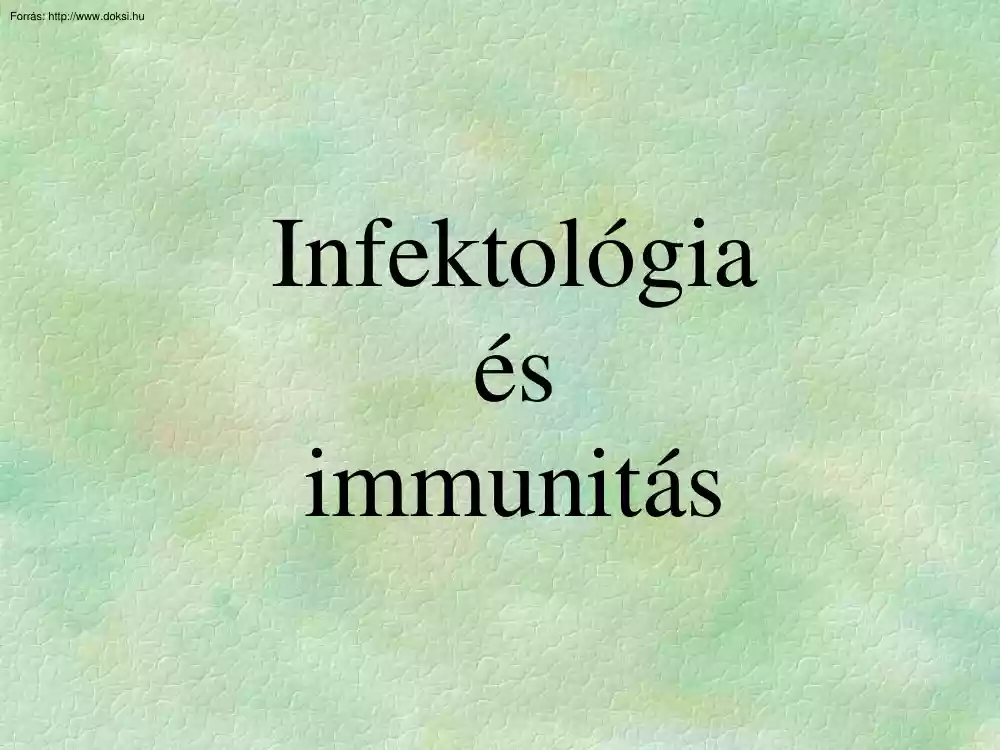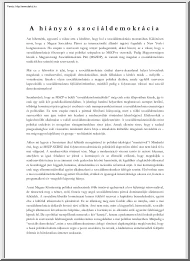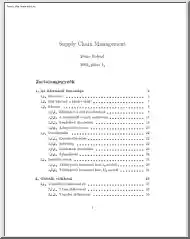Please log in to read this in our online viewer!

Please log in to read this in our online viewer!
No comments yet. You can be the first!
Content extract
Infektológia és immunitás ALAPFOGALMAK Infektológia Az infektológia a gyógyító-megelőző orvostudomány azon szakterülete, amely infekció (vide infra) révén kialakuló betegségek etiológiájával, patomechanizmusával, diagnosztikájával, kezelésével és megelőzésével foglalkozik. ALAPFOGALMAK Infekció Élő mikroorganizmusok bejutása a szervezetbe és szaporodása a szövetekben. Az infekció lehet tünetmentes vagy infektológiai betegség (vide infra) okozója. ALAPFOGALMAK Infektológiai betegség A szervezetben elszaporodó mikroorganizusok kompetitív metabolizmus, toxinhatás, intracelluláris replikáció vagy antigén-antitest reakció révén sejt- és szövetkárosító hatást váltanak ki, a patológiai folyamatok kórokozó-specifikus vagy a kórokozóra nem specifikus betegségi tüneteket, tünetegyütteseket, kórjeleket és szubjektív panaszokat okoznak, amelyek együttesét infektológiai betegségnek nevezünk. Changing
pattern of infectious diseases 1) Eradicated (smallpox) 2) Disappeared as endemic disease (Cholera, typhus) 3) Much less common (MMR, DiPerTe, TBC, scarlet. 4) Remained unchanged (RI, CNS, UTI, neonatal, infantile GI, VZ, hepatitis) 5) Increased (Food poisoning, STD, hospital infections) 6) New (AIDS, Lyme, Ehrlichiosis, Hantavirus) Transmission of infections 1) Airborne 2) Intestinal 3) Direct contact 4) Venereal route 5) Insect or animal bite 6) Blood-borne Control measures 1) Notification 2) Communicable disease control 3) International control measures FERTŐZÉS ÉS IMMUNITÁS Maródi László 2002. január 28 European Training for Paediatric Infectious Diseases and Immunology ESPHI/ESID/ESPID EBP/CESP 2002. május 1-2 Bacterial diseases Viral diseases Fungal diseases Protozoan Helminthic diseases diseases INFECTOLOGY Microbiology Immunology Epidemiology Molecular microbiology Molecular immunology Molecular epidemiology MOLECULAR BIOLOGY Az
infektológiai betegségek ellátáshoz szükséges szaktárgyi ismeretek Szaktárgyi ismeretek Etiológia immunológia mikrobiológia epidemiológia Patomechanizmus immunológia molekuláris biológia genetika Klinikai manifesztáció Immunológia kórokozó-specifikus tünetek kórokozó-specifikus szindrómák Terápia immunológia gyógyszertan mikrobiológia Prevenció immunológia epidemiológia EVOLUTION OF INFECTION Entry of the microbe Invasion of host tissues Colonization of host tissues Tissue injury Functional impairment Evasion from host immunity GENERAL FEATURES OF IMMUNITY TO MICROBES Defense is mediated by natural and acquired immunity Different types of microbes stimulate distinct lymphocyte responses and effector mechanisms Tissue injury may be caused by the host response to the microbe and its products MAJOR TYPES OF PATHOGENS Extracellular bacteria Intracellular bacteria Viruses Protozoan and
multicellular parasites EXTRACELLULAR BACTERIA Gram-positive cocci Gram-negative cocci Gram-positive bacilli Gram-negative bacilli I. IMMUNE RESPONSE TO EXTRACELLULAR BACTERIA MECHANISMS OF DISEASE CAUSED BY EXTRACELLULAR BACTERIA Induction of inflammation Production of toxins IMMUNOLOGIC RESPONSE AGAINST EXTRACELLULAR BACTERIA Elimination of bacteria Neutralization of toxins SPECIFIC IMMUNE RESPONSE TO EXTRACELLULAR BACTERIA Humoral immunity is the principal specific protective immune response T-dependent antigens T-independent antigens Three types of effector mechanisms Opsonization of bacteria Neutralization of toxins C-mediated lysis of bacteria Specifikus At koncentráció (ug/ml) H.influenzae b 40 30 A B C D 20 10 0 5x 100x IVIG hígítás Specifikus At koncentráció (ug/ml) 250 Pneumococcus 200 A B C D 150 100 50 0 50x 100x IVIG hígitás 400x Specifikus At koncentráció (ug/ml) 6 Pneumococcus, 4-es
szerotípus 4 A B C D 2 0 5x 125x IVIG hígítás 500x Specifikus At koncentráció (ug/ml) 12 Pneumococcus, 6B szerotípus 10 8 A B C D 6 4 2 0 5x 125x IVIG hígítás 500x Specifikus At koncentráció (ug/ml) Pneumococcus, 23F szerotípus 14 12 10 A B C D 8 6 4 2 0 5x 125x IVIG hígítás 500x NATURAL IMMUNITY TO EXTRACELLULAR BACTERIA Phagocytosis Complement activation Alternative pathway (peptidoglycan, LPS) Classical pathway (MBP) Cytokine production by macrophages TNF-, IL-1, IL-6, chemokines Pathologic consequences of cytokine release: 1) Induction of fever 2) Synthesis of acute phase proteins 3) Inflammation 4) Stimulation of T and B cells 5) Septic shock II. IMMUNE RESPONSE TO INTRACELLULAR BACTERIA INTRACELLULAR PATHOGENS Survive and replicate within host cells They are unaccessible to antibodies Examples: Bacteria (M.tuberculosis, M leprae, L. monocytogenes) Many fungi All viruses SPECIFIC IMMUNE RESPONSE TO INTRACELLULAR
BACTERIA Cell-mediated immunity is the principal specific protective immune response Protein antigens of intracellular bacteria stimulate CD4+ and CD8+ T cells Two types of effector mechanisms Killing of microbes by activated macrophages Lysis of infected cells by CTLs NATURAL IMMUNITY TO INTRACELLULAR PATHOGENS Phagocytosis Cytokine production by macrophages IL-12 (activate NK cells) SCID mice are able to control infection by L.monocytogenes! Immunologic analysis of the patient,s peripheral-blood lymphocytes Lymphocytes Type of cell Patient Normal range cell/l T cell CD3 + CD4 + CD8 + 228 182 23 B cell 1700-3600 1700-2800 800-1200 % CD19 + CD21 + 0.5 1.0 5-15 5-15 NK cell CD56 + 80 5-10 IFN- IL-2 T IFN- NK IFN-R Nucleus P STAT1 P ISRE Macrophage IL-12 Az IFN- aktivációs út MNP IL-12 IFN- IL-18 NK T Az IFN- aktivációs út primer defektusai Receptor deficientiák IFN-R1 deficientia Komplett IFN-R1
deficientia Partiális IFN-R1 deficientia Autosomális domináns IFN-R1 deficientia IFN-R2 deficientia Komplett IFN-R2 deficientia Partiális IFN-R2 deficientia IL-12R deficientia Komplett Il-12 1 lánc deficientia Citokin deficientiák IL-12 p40 alegység deficientia X-kromoszómához kötött IFN-/IL-12 deficientia Komplett IFN-R1 deficientia § AR öröklésmenet (génlocus:6q23-q24) § Kora gyermekkori kezdet § Súlyos, disseminált infekciók (M. avium, M fortuitum, M chelonei, M. smegmatis, S enteritidis, BCG) § Rossz prognózis § KLINIKUM: visszatérő láz, cachexia, hepatosplenomegalia, dermatitis granulomatosa, lymphadenomegalia, diffúz pneumonitis, multiplex osteolyticus laesiók § IMMUNOLÓGIAI LELETEK: a phagocytákon nem mutatható ki IFN- kötő receptor lánc (IFN-R1), csökkent TNF- termelés, kóros Ag feldolgozás és prezentálás § SZÖVETTAN: éretlen, alig differenciált, elmosott szélü, lepromatoid típusú
granulómák EVASION OF IMMUNE MECHANISMS BY INTRACELLULAR BACTERIA Anti-phagocytic mechanisms: 1) Inhibition of phago-lysosome fusion M.tuberculosis L.pneumophilia 2) Scavenging ROI M. leprae 3) Production of hemolysin L.monocytogenes SURVIVAL OF GROUP B STREPTOCOCCUS TYPE III IN RESIDENT AND CYTOKINE-ACTIVATED NEONATAL MACROPHAGES MORBIDITY § GBS are common cause of invasive infection and sepsis in l l l neonates, immunocompromised children, and adults with • cancer • diabetes mellitus • HIV infection • trauma • older age HOST DEFENSE MECHANISMS TO GBS § Opsonophagocytosis l l l l specific antibodies complement granulocytes monocytes § Macrophages (?) l l resident (?) activated (?) S. Berg et al, Antibodies to group B streptococci in neonates, Eur.JPediatr, 157:221, 1998 § Cord sera from 321 term babies l IgG CPS antibodies against GBS type Ia, II, and III were present in 98-100 % of all cord samples § Sera collected at 2,3,8,13, and 26
weeks of age IgG Abs decreased continually during the first 6 months of life l only 16-17 % of children acquired IgM Abs at 3-6 months of age l MATERIALS § § § § § Monocytes Monocyte-derived macrophages Group B streptococcus type III Cytokines (rIFN-, rGM-CSF) Antibodies l l l l mouse IgG2b (anti-IFN-R) mouse IgG1 (anti-IFN-R) mouse IgG2b (anti-STAT1) rabbit IgG (anti-p-STAT1) METHODS § § § § § § § Cell culture Phagocytosis Preopsonization Killing INF- binding IFN-R expression STAT-1 phosphorylation Percentage of viable extracellular bacteria Phagocytosis of GBS type III by macrophages 100 Unopsonized, cord Unopsonized, adult Opsonized, cord Opsonized, adult 50 0 0 30 Incubation time (min) 60 Percentage of viable bacteria Killing of GBS type III by macrophages 100 Unopsonized, cord Unopsonized, adult Opsonized, cord Opsonized, adult 50 0 0 60 Incubation time (min) 120 Phagocytosis and killing of GBS type III by resident and
cytokine-activated macrophages Percentage Phagocytosis Killing Resident 50 IFN-g-treated GM-CSF-treated 0 Cord Adult Cord Adult Expression of IFN-gamma receptors on cord and adult macrophages mAb-binding (%) 100 75 Mouse IgG2b Mouse IgG1 MY-4 50 25 0 Cord Adult Binding capacity of IFN-R on cord and adult macrophages Specific binding (cpm) 4000 3000 2000 Cord Adult 1000 0 12.5 pM 25.0 pM 125-I-IFN-gamma 50.0 pM Fluorescence intensity of p-STAT-positive macrophages Dose-dependent response for STAT-1 phosphorylation in macrophages 200 150 100 Cord Adult Adult 50 0 0 10 100 1000 Concentration of IFN-gamma (U/ml) STAT-1 phosphorylation in cord and adult macrophages exposed to IFN-gamma Fluorescence intensity of p-STAT-positive macrophages P<0.01 150 100 Cord Adult 50 0 Control 0 100 Concentration of IFN-gamma (U/ml) Antibody binding to STAT-1 in cord and adult macrophages
Fluorescence intensity of STAT-positive macrophages Condition ---------------------------------------------------------------------Cord cells Adult cells p Control IFN- (0 U/ml) 6+4 6+4 NS 141 + 16 164 + 22 NS 289 + 45 NS IFN- (100 U/ml) 264 + 36 SUMMARY-1 § Macrophages from cord and adults ingest ops. GBS § Killing of bacteria was < 20% by resident cells § Cytokine-treatment of adult macrophages resulted in significantly killing of GBS § GM-CSF-treatment of cord MDM killing of GBS § Cord MDM cannot be fully activated by IFN- SUMMARY-2 § The deficiency of cord MDM response to stimulation with IFN- could not be explained by decreased numbers of IFN-R on cord cells l decreased affinity of IFN-R to their natural ligand (IFN-) l SUMMARY-3 § STAT-1 phosphorylation in response to IFN-
(10-1000 U/ml) was significantly decreased in neonatal macrophages at each concentration (p<0.01) CONCLUSIONS § The decreased capacity of neonatal macrophages for activation by IFN- may lie at the level of transcription § IFN- and GM-CSF differentially modulate cord macrophages § Administration of GM-CSF to neonates with invasive GBS disease may enhance host resistance to these bacteria Publikációk § Maródi L et al. § Maródi L § Maródi L et al. § Maródi L § Maródi L et al. § 1994. J Immunol 153:5643-5649 1997. Pediatr Infect Dis J 16:795-801 1998. Infect Immun 66:2750-2754 2001. Pediatr Res 49:316 2001. Clin Exp Immunol 126:456-460 CANDIDAL DISEASES A) INVASIVE (20) Candidemia Suspected disseminated candidiasis Acute hematogenously disseminated candidiasis Chronic disseminated candidiasis Hepatosplenic candidiasis Disseminated cutaneous candidiasis Urinary candidiasis Candidal pneumonia Laryngeal candidiasis Candidal osteomyelitis Candidal
arthritis Candidal mediastinitis Candidal infection of the gallblader Candidal infection of the pancreas Candidal infection of the peritoneum Candidal endocarditis Candidal pericarditis Candidal suppurative phlebitis Candidal meningitis Candidal endophthalmitis B) MUCOCUTANEOUS (6) Nongenital mucocutaneous candidiasis Oropharyngeal candidiasis Esophageal candidiasis Candida onychomycosis Candidal paronychia Chronic mucocutaneous candidiasis Genital candidiasis Köszönöm a figyelmet!
pattern of infectious diseases 1) Eradicated (smallpox) 2) Disappeared as endemic disease (Cholera, typhus) 3) Much less common (MMR, DiPerTe, TBC, scarlet. 4) Remained unchanged (RI, CNS, UTI, neonatal, infantile GI, VZ, hepatitis) 5) Increased (Food poisoning, STD, hospital infections) 6) New (AIDS, Lyme, Ehrlichiosis, Hantavirus) Transmission of infections 1) Airborne 2) Intestinal 3) Direct contact 4) Venereal route 5) Insect or animal bite 6) Blood-borne Control measures 1) Notification 2) Communicable disease control 3) International control measures FERTŐZÉS ÉS IMMUNITÁS Maródi László 2002. január 28 European Training for Paediatric Infectious Diseases and Immunology ESPHI/ESID/ESPID EBP/CESP 2002. május 1-2 Bacterial diseases Viral diseases Fungal diseases Protozoan Helminthic diseases diseases INFECTOLOGY Microbiology Immunology Epidemiology Molecular microbiology Molecular immunology Molecular epidemiology MOLECULAR BIOLOGY Az
infektológiai betegségek ellátáshoz szükséges szaktárgyi ismeretek Szaktárgyi ismeretek Etiológia immunológia mikrobiológia epidemiológia Patomechanizmus immunológia molekuláris biológia genetika Klinikai manifesztáció Immunológia kórokozó-specifikus tünetek kórokozó-specifikus szindrómák Terápia immunológia gyógyszertan mikrobiológia Prevenció immunológia epidemiológia EVOLUTION OF INFECTION Entry of the microbe Invasion of host tissues Colonization of host tissues Tissue injury Functional impairment Evasion from host immunity GENERAL FEATURES OF IMMUNITY TO MICROBES Defense is mediated by natural and acquired immunity Different types of microbes stimulate distinct lymphocyte responses and effector mechanisms Tissue injury may be caused by the host response to the microbe and its products MAJOR TYPES OF PATHOGENS Extracellular bacteria Intracellular bacteria Viruses Protozoan and
multicellular parasites EXTRACELLULAR BACTERIA Gram-positive cocci Gram-negative cocci Gram-positive bacilli Gram-negative bacilli I. IMMUNE RESPONSE TO EXTRACELLULAR BACTERIA MECHANISMS OF DISEASE CAUSED BY EXTRACELLULAR BACTERIA Induction of inflammation Production of toxins IMMUNOLOGIC RESPONSE AGAINST EXTRACELLULAR BACTERIA Elimination of bacteria Neutralization of toxins SPECIFIC IMMUNE RESPONSE TO EXTRACELLULAR BACTERIA Humoral immunity is the principal specific protective immune response T-dependent antigens T-independent antigens Three types of effector mechanisms Opsonization of bacteria Neutralization of toxins C-mediated lysis of bacteria Specifikus At koncentráció (ug/ml) H.influenzae b 40 30 A B C D 20 10 0 5x 100x IVIG hígítás Specifikus At koncentráció (ug/ml) 250 Pneumococcus 200 A B C D 150 100 50 0 50x 100x IVIG hígitás 400x Specifikus At koncentráció (ug/ml) 6 Pneumococcus, 4-es
szerotípus 4 A B C D 2 0 5x 125x IVIG hígítás 500x Specifikus At koncentráció (ug/ml) 12 Pneumococcus, 6B szerotípus 10 8 A B C D 6 4 2 0 5x 125x IVIG hígítás 500x Specifikus At koncentráció (ug/ml) Pneumococcus, 23F szerotípus 14 12 10 A B C D 8 6 4 2 0 5x 125x IVIG hígítás 500x NATURAL IMMUNITY TO EXTRACELLULAR BACTERIA Phagocytosis Complement activation Alternative pathway (peptidoglycan, LPS) Classical pathway (MBP) Cytokine production by macrophages TNF-, IL-1, IL-6, chemokines Pathologic consequences of cytokine release: 1) Induction of fever 2) Synthesis of acute phase proteins 3) Inflammation 4) Stimulation of T and B cells 5) Septic shock II. IMMUNE RESPONSE TO INTRACELLULAR BACTERIA INTRACELLULAR PATHOGENS Survive and replicate within host cells They are unaccessible to antibodies Examples: Bacteria (M.tuberculosis, M leprae, L. monocytogenes) Many fungi All viruses SPECIFIC IMMUNE RESPONSE TO INTRACELLULAR
BACTERIA Cell-mediated immunity is the principal specific protective immune response Protein antigens of intracellular bacteria stimulate CD4+ and CD8+ T cells Two types of effector mechanisms Killing of microbes by activated macrophages Lysis of infected cells by CTLs NATURAL IMMUNITY TO INTRACELLULAR PATHOGENS Phagocytosis Cytokine production by macrophages IL-12 (activate NK cells) SCID mice are able to control infection by L.monocytogenes! Immunologic analysis of the patient,s peripheral-blood lymphocytes Lymphocytes Type of cell Patient Normal range cell/l T cell CD3 + CD4 + CD8 + 228 182 23 B cell 1700-3600 1700-2800 800-1200 % CD19 + CD21 + 0.5 1.0 5-15 5-15 NK cell CD56 + 80 5-10 IFN- IL-2 T IFN- NK IFN-R Nucleus P STAT1 P ISRE Macrophage IL-12 Az IFN- aktivációs út MNP IL-12 IFN- IL-18 NK T Az IFN- aktivációs út primer defektusai Receptor deficientiák IFN-R1 deficientia Komplett IFN-R1
deficientia Partiális IFN-R1 deficientia Autosomális domináns IFN-R1 deficientia IFN-R2 deficientia Komplett IFN-R2 deficientia Partiális IFN-R2 deficientia IL-12R deficientia Komplett Il-12 1 lánc deficientia Citokin deficientiák IL-12 p40 alegység deficientia X-kromoszómához kötött IFN-/IL-12 deficientia Komplett IFN-R1 deficientia § AR öröklésmenet (génlocus:6q23-q24) § Kora gyermekkori kezdet § Súlyos, disseminált infekciók (M. avium, M fortuitum, M chelonei, M. smegmatis, S enteritidis, BCG) § Rossz prognózis § KLINIKUM: visszatérő láz, cachexia, hepatosplenomegalia, dermatitis granulomatosa, lymphadenomegalia, diffúz pneumonitis, multiplex osteolyticus laesiók § IMMUNOLÓGIAI LELETEK: a phagocytákon nem mutatható ki IFN- kötő receptor lánc (IFN-R1), csökkent TNF- termelés, kóros Ag feldolgozás és prezentálás § SZÖVETTAN: éretlen, alig differenciált, elmosott szélü, lepromatoid típusú
granulómák EVASION OF IMMUNE MECHANISMS BY INTRACELLULAR BACTERIA Anti-phagocytic mechanisms: 1) Inhibition of phago-lysosome fusion M.tuberculosis L.pneumophilia 2) Scavenging ROI M. leprae 3) Production of hemolysin L.monocytogenes SURVIVAL OF GROUP B STREPTOCOCCUS TYPE III IN RESIDENT AND CYTOKINE-ACTIVATED NEONATAL MACROPHAGES MORBIDITY § GBS are common cause of invasive infection and sepsis in l l l neonates, immunocompromised children, and adults with • cancer • diabetes mellitus • HIV infection • trauma • older age HOST DEFENSE MECHANISMS TO GBS § Opsonophagocytosis l l l l specific antibodies complement granulocytes monocytes § Macrophages (?) l l resident (?) activated (?) S. Berg et al, Antibodies to group B streptococci in neonates, Eur.JPediatr, 157:221, 1998 § Cord sera from 321 term babies l IgG CPS antibodies against GBS type Ia, II, and III were present in 98-100 % of all cord samples § Sera collected at 2,3,8,13, and 26
weeks of age IgG Abs decreased continually during the first 6 months of life l only 16-17 % of children acquired IgM Abs at 3-6 months of age l MATERIALS § § § § § Monocytes Monocyte-derived macrophages Group B streptococcus type III Cytokines (rIFN-, rGM-CSF) Antibodies l l l l mouse IgG2b (anti-IFN-R) mouse IgG1 (anti-IFN-R) mouse IgG2b (anti-STAT1) rabbit IgG (anti-p-STAT1) METHODS § § § § § § § Cell culture Phagocytosis Preopsonization Killing INF- binding IFN-R expression STAT-1 phosphorylation Percentage of viable extracellular bacteria Phagocytosis of GBS type III by macrophages 100 Unopsonized, cord Unopsonized, adult Opsonized, cord Opsonized, adult 50 0 0 30 Incubation time (min) 60 Percentage of viable bacteria Killing of GBS type III by macrophages 100 Unopsonized, cord Unopsonized, adult Opsonized, cord Opsonized, adult 50 0 0 60 Incubation time (min) 120 Phagocytosis and killing of GBS type III by resident and
cytokine-activated macrophages Percentage Phagocytosis Killing Resident 50 IFN-g-treated GM-CSF-treated 0 Cord Adult Cord Adult Expression of IFN-gamma receptors on cord and adult macrophages mAb-binding (%) 100 75 Mouse IgG2b Mouse IgG1 MY-4 50 25 0 Cord Adult Binding capacity of IFN-R on cord and adult macrophages Specific binding (cpm) 4000 3000 2000 Cord Adult 1000 0 12.5 pM 25.0 pM 125-I-IFN-gamma 50.0 pM Fluorescence intensity of p-STAT-positive macrophages Dose-dependent response for STAT-1 phosphorylation in macrophages 200 150 100 Cord Adult Adult 50 0 0 10 100 1000 Concentration of IFN-gamma (U/ml) STAT-1 phosphorylation in cord and adult macrophages exposed to IFN-gamma Fluorescence intensity of p-STAT-positive macrophages P<0.01 150 100 Cord Adult 50 0 Control 0 100 Concentration of IFN-gamma (U/ml) Antibody binding to STAT-1 in cord and adult macrophages
Fluorescence intensity of STAT-positive macrophages Condition ---------------------------------------------------------------------Cord cells Adult cells p Control IFN- (0 U/ml) 6+4 6+4 NS 141 + 16 164 + 22 NS 289 + 45 NS IFN- (100 U/ml) 264 + 36 SUMMARY-1 § Macrophages from cord and adults ingest ops. GBS § Killing of bacteria was < 20% by resident cells § Cytokine-treatment of adult macrophages resulted in significantly killing of GBS § GM-CSF-treatment of cord MDM killing of GBS § Cord MDM cannot be fully activated by IFN- SUMMARY-2 § The deficiency of cord MDM response to stimulation with IFN- could not be explained by decreased numbers of IFN-R on cord cells l decreased affinity of IFN-R to their natural ligand (IFN-) l SUMMARY-3 § STAT-1 phosphorylation in response to IFN-
(10-1000 U/ml) was significantly decreased in neonatal macrophages at each concentration (p<0.01) CONCLUSIONS § The decreased capacity of neonatal macrophages for activation by IFN- may lie at the level of transcription § IFN- and GM-CSF differentially modulate cord macrophages § Administration of GM-CSF to neonates with invasive GBS disease may enhance host resistance to these bacteria Publikációk § Maródi L et al. § Maródi L § Maródi L et al. § Maródi L § Maródi L et al. § 1994. J Immunol 153:5643-5649 1997. Pediatr Infect Dis J 16:795-801 1998. Infect Immun 66:2750-2754 2001. Pediatr Res 49:316 2001. Clin Exp Immunol 126:456-460 CANDIDAL DISEASES A) INVASIVE (20) Candidemia Suspected disseminated candidiasis Acute hematogenously disseminated candidiasis Chronic disseminated candidiasis Hepatosplenic candidiasis Disseminated cutaneous candidiasis Urinary candidiasis Candidal pneumonia Laryngeal candidiasis Candidal osteomyelitis Candidal
arthritis Candidal mediastinitis Candidal infection of the gallblader Candidal infection of the pancreas Candidal infection of the peritoneum Candidal endocarditis Candidal pericarditis Candidal suppurative phlebitis Candidal meningitis Candidal endophthalmitis B) MUCOCUTANEOUS (6) Nongenital mucocutaneous candidiasis Oropharyngeal candidiasis Esophageal candidiasis Candida onychomycosis Candidal paronychia Chronic mucocutaneous candidiasis Genital candidiasis Köszönöm a figyelmet!




 When reading, most of us just let a story wash over us, getting lost in the world of the book rather than paying attention to the individual elements of the plot or writing. However, in English class, our teachers ask us to look at the mechanics of the writing.
When reading, most of us just let a story wash over us, getting lost in the world of the book rather than paying attention to the individual elements of the plot or writing. However, in English class, our teachers ask us to look at the mechanics of the writing.